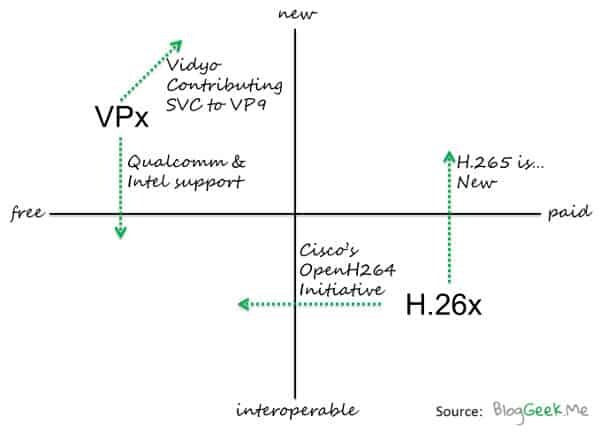VP8 is a placeholder – nothing more.
With all this fighting going around between H.264 and VP8, we’re forgetting the bigger picture here. And that is the fact that VP8… or H.264… are just a footnote.

I remember back in my days, we talked about H.263. And then H263+. And then H.263++. And then about this brand new thing called H.264. And how it is great. But can’t be used anywhere because it just too darn expensive to run. At that time, H.263 was ubiquitous.
Today? Today, H.264 is great, but getting a bit old and boring. VP8 isn’t that different, though you might call it “newer”.
There are 3 new players in town – ones you should know about:
H.265
H.265 is the continuation of H.264 for all intents and purposes.
It is just as boring (besides for the technologists), and it just as expensive – it comes with the usual hefty sum you’ll need to pay (probably to MPEG-LA as well).
While its future in WebRTC depends on H.264 being selected as the mandatory codec, it seems that its future in the streaming industry, at least if you ask content creators, is bright.
Oh… and it has another name, just to confuse us all: HEVC – High Efficiency Video Coding. As if H.266 won’t be any more efficient.
I wonder if Cisco will be “open sourcing” this codec with all of its patents so happily as well.
VP9
VP9 is the continuation of VP8 for all intents and purposes.
Google is pushing it full steam ahead, and they are using whatever ammunition they have – placing this codec in YouTube and in their Chrome browser in its current state. They WANT it to be the web standard for video.
To make things interesting, Google has thrown SVC (Scalable Video Coding) into the mix here, by partnering again with Vidyo, to get their SVC magic into VP9.
Daala
Daala. Daala is an attempt by Mozilla to bring its own free, open source codec. Something that surpasses H.265 without patents. It is so new that the first real encoded stream was achieved in May 2013. To me this means there’s a long way to go here.
I find it hard to believe it will garner more of our attention in the next 3-4 years.
With codecs usually having a run of a decade, not sure where that leaves Daala.
–
We’re no fighting over VP8 and H.264 not for the sake of having them in WebRTC, but rather for the selection of the future codec – the one that will rule the internet, and maybe even paid video content. There are a lot of interested parties in this game – many with patents they plan on monetizing.
Getting out of the path of patented video codecs will benefit us all. It will spur more innovation and reduce barriers of entry for new and interesting services. It will also simplify licensing and legal issues related to patent royalty payments.
I wish the end result will not include an ‘H’ prefix in it.
–
All that said, a few people already told me they just couldn’t care less as long as we end up with a single codec – their use case just needs whatever codec there is.
I guess we’re making a bit too much of a fuss about it.

The chart looks good, but the claim that VP8 is free is not quite right. It also has patents covering it and could be subjected to even higher royalties than H.264. Worse, as patent holder could even kill your product.
If Google wants to claim it is free, they should indemnify users against patent claims. They won’t, though, because they know there is a huge risk.
Paul,
Two things here. The first one, a two axis diagram can never have the complexity of real world in it, so yes, it is missing pieces of reality.
The second one is more important – I care more about what VP8 stands for than nuances of who still holds patents to it and can threaten the buiding ecosystem. At the end of the day, VPx puts us as an industry on a track towards free codecs instead of royalty bearing ones – and that’s a good thing, assuming it can come to fruition.
I understand your point, but the companies that will work on any of these free codecs are the same ones that contribute to H.264 and H.265. If they wanted, they could make H.265 royalty free. I think everyone would agree that’s good for the industry. However, too many companies, for whatever reason, have always been protective of IPR on both voice and video coding.
Not necessarily.
We now have Opus, another free codec (with its own IPR issues).
And there’s Daala, with the soul attempt of being totally free. And VP9 – where the company in question wants to make it free. It isn’t the same people and their respective companies have different business models.
Apologies for butting in on a fascinating technical debate. As an economist I am intrigued by the conditions that enable adoption and development of new ideas. As the website http://webrtcapac.com/ will tell you I am involved in running two events on WebRTC in HK and SG in January. Can you recommend any “neutral” speaker from my region who could introduce this debate in fairly layman terms?